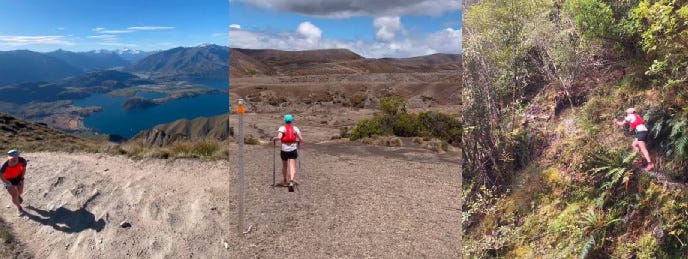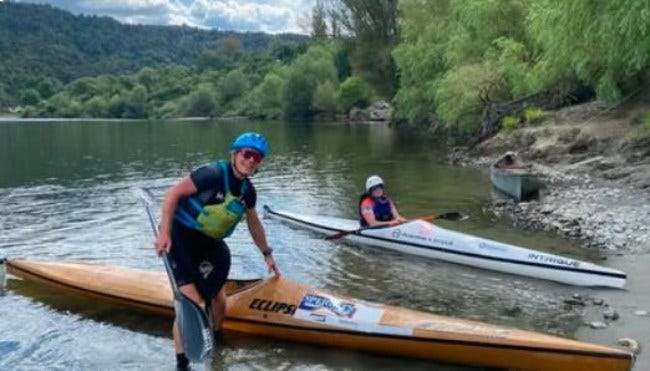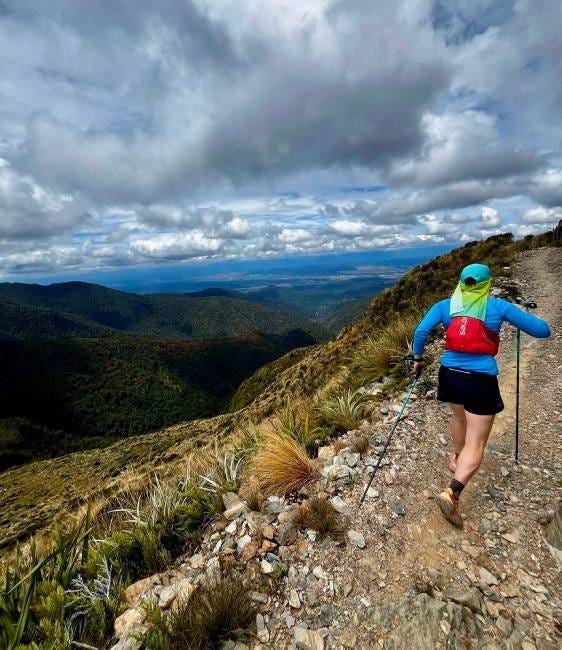Bridget Johnson Diaries:
11 Great Walks in 11 Days
In the last 2 weeks, we’ve followed Bridget Johnson’s progress in her mission to be the first person to complete our 11 great walks (Humpridge has been added) in 11 days. Last Monday, she just had Humpridge and Rakiura to go.
Well … she did it!
I didn’t think 11 Great Walks in 11 days was a big enough endurance test, so I sent her a sh💩t tonne of questions.
Let’s jump right in.
Q1: What inspired you to take on the challenge of completing all 11 Great Walks in 11 days?
“I first heard about the challenge many many years ago when some people were doing 7 in 7. I then followed along as Andrew Robinson did a 10 in 10 back in 2021 and found the whole thing super cool and inspiring.”
“I guess what really piqued my interest in this particular challenge. I then did a solo fastpacking trip in August last year while training for a 100km race — on this, I realised that I could push all day and then get up the next day and go again. I was interested to really see what that meant and what I could achieve if I really trained, backing it up day after day.”
“I think one of the coolest things about the Great Walks is that in a way they are super accessible. Lots of people have an experience tramping on a Great Walk and that makes a multi-day attempt involving many Great Walks accessible and relatable because they feel they can connect and relate to what you are doing much more than with a 100 mile race for example. I think this forms a cool platform to inspire and motivate others.”
Q2: How much planning went into this, and what were the biggest logistical hurdles?
“A huge amount of planning went into the project. There were spreadsheets with a lot of tabs. All sections had plan A, B, and C and we had also run through a whole range of contingency plans (none of which we really needed luckily).”
“The biggest logistics really were the transition from the North Island to the South Island, and really the hidden crux of the project is actually the Abel Tasman tides. You need to line yourself up with boats/planes or other transport to get yourself to a specific part of the trail right at low tide.”
“Knowing we weren’t going to make the tides my crew had brought in a super light weight packraft, but it was too windy to safely paddle across. Luckily a local fisherman Grant offered to take me across the Awaroa Inlet (shout out Grant!).”
Q3: Who supported you during the mission?
“I had an incredible amount of support through the project all told around 30 people were part of it in a range of ways. My husband Jim Murphy was crew chief and also ran almost half the milage of the project in various ways throughout some pacing, some crewing.”
“We had broken the lines up into 3 sections (North Island, North of the South, and South of the South). I was lucky enough to have Ali Wilson and Liz McDougall support me on the Northern Circuit and the river. Getting to spend time with these two phenomenal athletes was so inspiring and really set the vibe strong for me for the rest of the trip.”
“I then had good made Blake Johnston join for the north of the south who paced Paparoa and repositioned the crew vehicle while Jim and I ran Heaphy. My parents then flew over from Aus to support us once we got to the Queenstown area which was perfect timing to get some fresh energy and people happy to cook us dinner and do the laundry.”
“We had a fantastic crew of six runners on the Milford track with me which kept the vibes high all day, and local Queenstown runner Ben Gatting paced me on the Kepler as the last training run for his own 11in11 attempt (starting this week) and it was only possible with everyone working together so smoothly and encouraging me along the way.”
“Allira Hanczakowski also joined Ali and I on the Northern Circuit and with her fast packing experience she had some great insights, then a friend of hers Lauren Catalano who saw the project online jumped in last minute for a portion of Abel Tasman which was a big help as I didn’t have any other pacers that day.”
“I also want to shout out to the Wellington Kupe Kayak Club beginners group and Paul Moreno who helped me train and learn to paddle, as well as Ben Foughy who runs fantastic Grade Two Kayak courses in Taupo. These guys gave me the confidence I needed on the river which was one of the most difficult legs.”
Q4: Were you more excited or nervous before starting?
“Honestly I tried not to think too much about the full project in those days before, the mind set going in was very one day at a time.”
“Each day just have as much fun as possible for as long as possible and be grateful to be on the adventure.”
Q5: Which Great Walks had you previously tramped or ran?
“I had done quite a few Great Walks before, some I had run and some I had tramped with my dad.”
“It was great on the project to have some familiar areas but also super exciting to do runs like Heaphy, Paparoa, and Hump Ridge, all of which were parts of the country I had never been too.”
Q6: What was the toughest moment of the whole challenge?
“Coming into the project as an ultrarunner it was the river that kept me up at night. I knew what running 80km in a day felt like but before starting out on the river the longest I had ever paddled was 22km.”
“At the end of the second day paddling my whole body hurt and I could hardly lift my arms let alone hold anything in my hands. I just tried to remember I actually only really needed my legs for the next day and they weren’t so bad.”
Q7: Were you ever close to quitting?
“I never really got close to quitting. One thing about having such a huge support network in place was there was a lot of people who had put their own lives aside to support this dream for me.”
“Knowing they had done that there was no way I was going down without a fight, so we just maintained that ‘one day at a time’ approach and woke up each day ready for the next adventure.”
Q8: Was there a moment where you knew you were going to pull it off?
“When I made it to the South Island and realised even with a completely trashed upper body (after the river) I could still run I knew it was going to possible, but with so many logistics involved and many of them outside of our control it really wasn’t until the wheels of the plane to Rakiura touched down that I was pretty sure we had it.”
“I did run Rakiura very slow and carefully though thinking to myself “Do not blow everything by turning an ankle now”.
Q9: How did your body hold up? Any injuries?
“Things would pop up for a day or two all the time, but nothing that really lingered throughout or didn’t feel like it would warm up throughout the day.”
“The worst was probably the blisters on my hands and swelling in my wrist after the river. I was struggling to use my left hand at all, but luckily it didn’t last too long and a day or two of running without my poles seemed to be all it took to get that under control.”
Q10: That’s a lot of hours back to back of having to eat a tonne of food. What was your nutrition strategy?
“I was lucky enough to be supported in the project by Mark and Fibi from Tailwind NZ so Tailwind played a huge role in my nutrition strategy throughout.”
“I also make my own gels so had made around the equivalent of 96 gels before we started (for both myself and Jim). We knew the sweet fatigue was going to be a big factor and also that running at a much lower pace than in a ‘race’ I took on a lot more ‘real food’ then I normally would whilst running.”
“We would pack little ziplocks of what became known as my cruncho’s — essentially any small treat that was savoury and had a crunch to it. I also had the support of GoNative NZ who do amazing meals and particularly instant mashed potatoes so me and the crew were utilising those a lot throughout too.”
“I think a real key to the success was the rule that I had to get in at least 30 grams of protein as soon as we finished each run. This set the recovery up to make sure I was ready for the next day, once I knew I had that protein sorted we would move on to pizza or pasta or whatever the crew put in front of me that night.”
Q11: Did you find it hard to sleep knowing you had to do it all over again the next day?
“Sleep actually really became the theme of the whole trip. I knew optimising as much sleep as possible between runs would give me the best chance of success so as soon as I finished each run I would discuss and set sleep goals with the crew.”
“Knowing if we transitioned and recovered quickly that could mean an extra hour sleep at night which made a huge difference to being able to move well the next day. I would roll into wherever we were sleeping put on noise cancelling headphones and a black out mask and usually was so tired I was out within minutes.”
Q12: What was your biggest change in plans along the way?
“We really got so lucky with weather and conditions along the way that we didn’t need to do any big re arrangements along the way.”
“The biggest was just delaying the start of Hump Ridge by an hour to let a system with a lot of rain in it pass over, which for a project of this scale is honestly insignificant.”
Q13: What was the toughest transition between walks?
“The drive between the end of Paparoa on the West Coast and the start of the Routeburn down near Queenstown was brutal.”
“We drove through the night keeping an eye out for 24 hour petrol stations on the coast, and only saw one other car between Fox Glacier and Wanaka.”
“Jim did the driving while I tried to rest as much as possible and this was as much of an endurance pursuit as any of the running we did along the way.”
Q14: Did the weather play ball, or were there some hairy moments?
“We got insanely lucky with the weather. A few light sprinkles on Milford and Kepler and a couple of rain bands passing through on Hump Ridge but honestly nothing at all that was tough to run in. It also didn’t really get too hot on anything.”
“It couldn’t have possibly gone better on that front. Ironically the night we finished on Rakiura a big front moved across and we got to listen to it absolutely batter down knowing it was all over and we didn’t need to go out in it (made for an exciting flight back to the mainland though).”
Q15: What was the best view or scene from the trip you experienced?
“The beauty of the Great Walks is that they really are curated to be hugely diverse, every run had epic view in and of its own right.”
“Some highlights though of course were getting clear conditions up over McKinnon Pass on the Milford and at the saddle on the Routeburn. There really were so many moments where you just took a breath and thought ‘wow this is an epic adventure.’”
“In another sense some of the most memorable views were when things had gotten tough and I would come around the corner to see Jim or another mate who had run in to help bring me out the last few kilometres of a track.”
Q16: Which one was better than you expected?
“I think more people should go run Waikaremoana. It was one that I knew least about going into it, so much so that we went up for a recce a few weeks before to make sure everything was actually going to work.”
“It’s easy to think of the Great Walks as mostly being about the bigger mountains down south but this walk really has some spectacular running.”
Q17: If you were to hand out an overrated award to one, which one would it be?
“I really couldn’t possible say one of them is over rated. They are all so different and when you put them back to back like we did it is truly a fantastic snapshot of everything that is great about trail running in New Zealand.”
Q18: If you could only ever go back to do one of them again, which one would it be and why?
“Being based in Wellington the Northern Circuit is a bit of a classic training ground for me, I think I’ve done it 4 or 5 times now and I’m sure it won’t be too long before I run this one again. “
“But having now done two of the Great Walks as tramps with my dad I think he would love the Heaphy so hopefully I can line that up with him soon.”
Q19: What did you learn about yourself?
“Writing this on the ferry on the way back to the North Island, I really found the whole experience so rewarding in so many ways. I had gained so much from it even before we actually started just through the training and preparation.”
“I think it might take some time before I really reflect and understand what this means now but I will say that having thought this project might show me my physical and mental limits I think we might actually need to keep going to find them.”
Q20: If someone wanted to attempt the same thing what advice would you give them?
“Your crew really is everything; trust them, respect them, and let them support you. In training I would say that weighted hill reps are horrible but also get your body ready like no other training I know.”
“Also you should for sure learn to paddle. The Whanganui Journey is such that you can turn up without much experience and get to the other end safely in a few days time but that is very different to backing up 60km paddles with 90km paddles.”
Q21: Any plans for an even bigger adventure?
“I think the best goals in life are the ones where you feel like it probably is possible but you go into it not actually knowing if you can pull it off or not.”
“This project was absolutely that for me and I was so focused on it that I haven’t really thought at all about what is next. I know I enjoyed the logistics planning and training as much as the actually running.”
“I also found it at least as rewarding as racing (probably more really). So who knows how that will manifest.”
Congratulations Bridget - Mission Accomplished. You can follow Bridget on Insta to keep track of her next adventures.
So, who’s next?
Ben Gatting this coming Thursday! Ben is a Queenstown runner who paced Bridget on the Kepler as his last training run for his own attempt.
He’s raising money for Kiwi Harvest a charity that helps distribute food out to people who really need it.
You can follow along with his attempt on Insta Here









